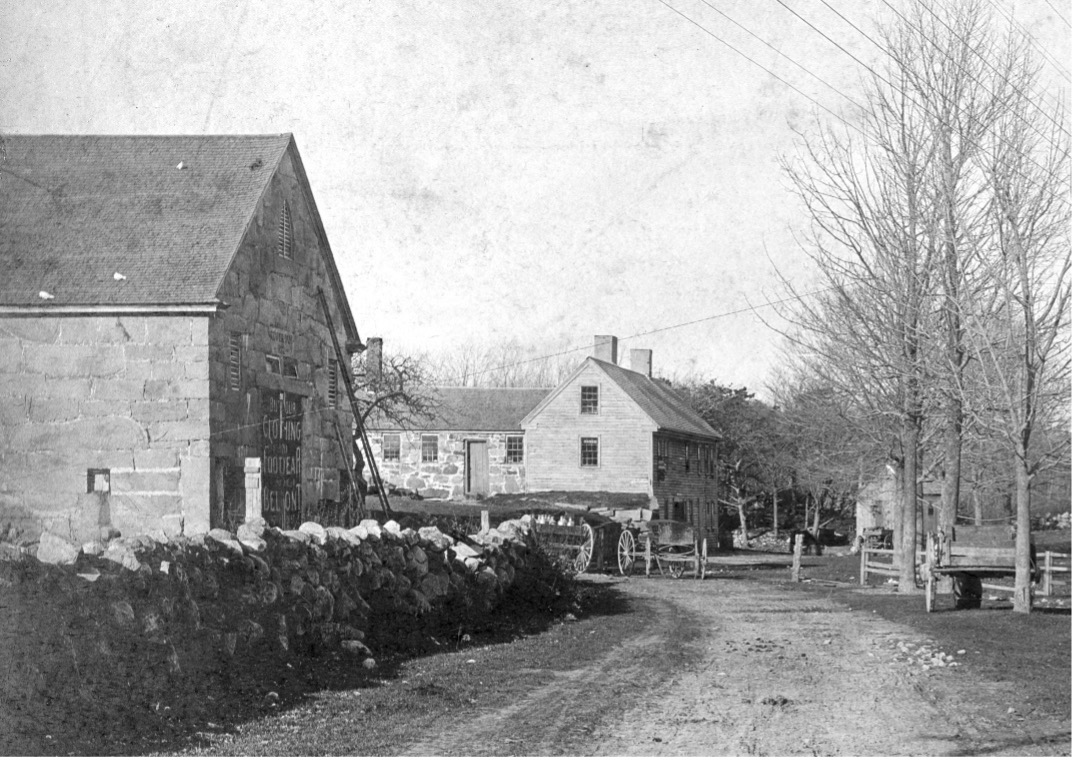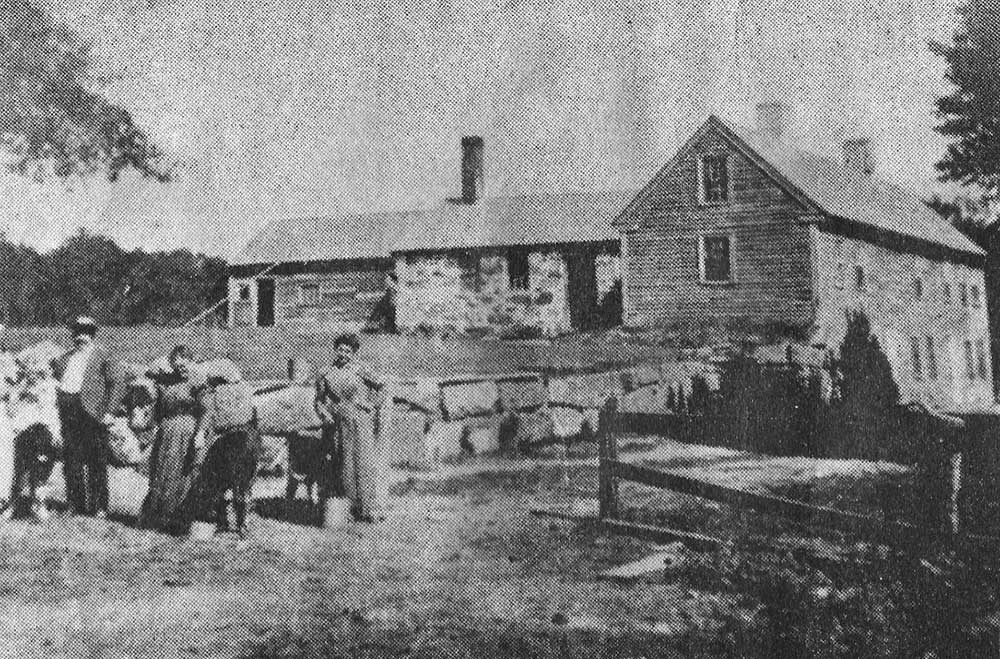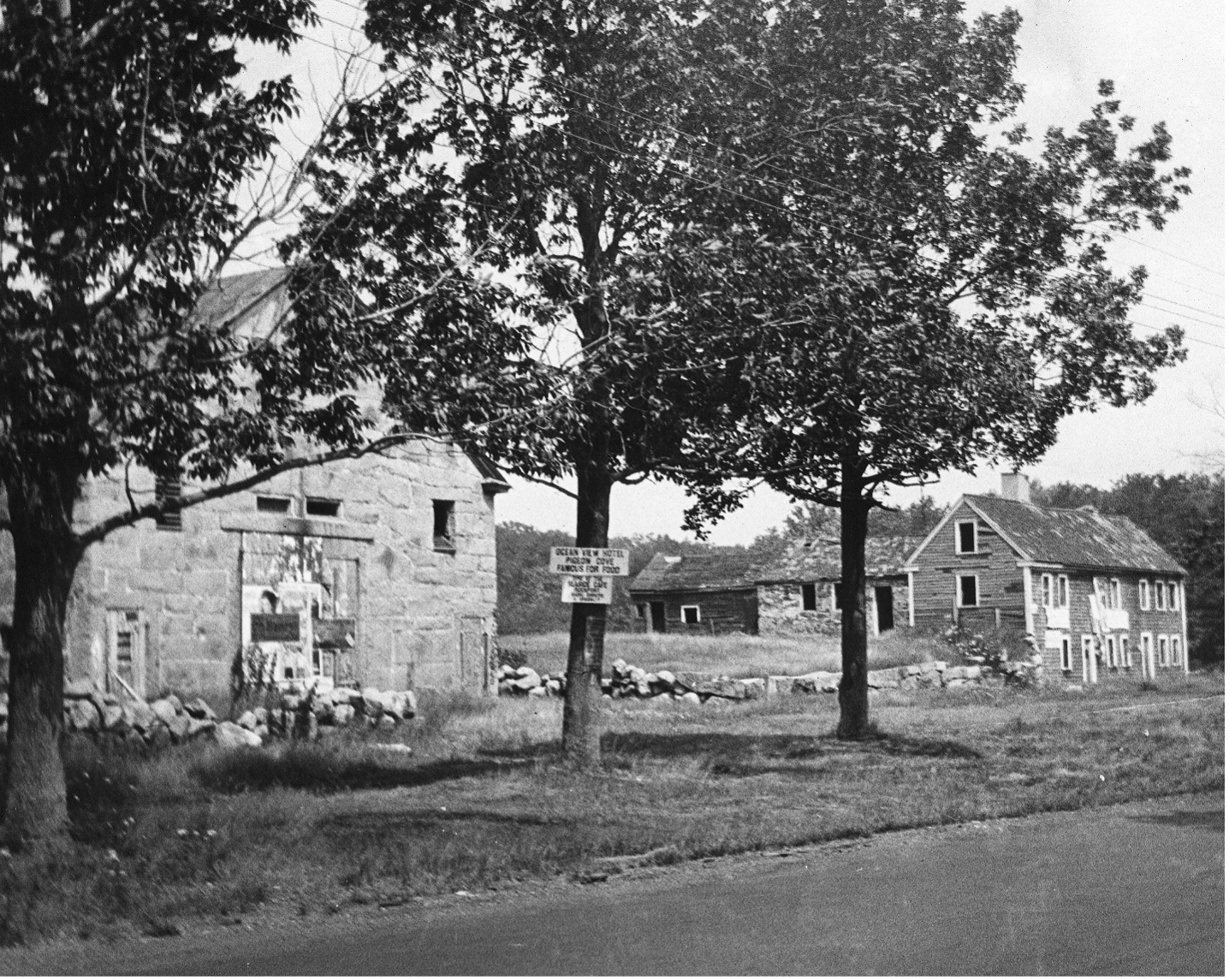As with many older Colonial structures, particularly those associated with a particular family, historical fact and family legends do not always offer complementary perspectives. The structure which houses the James Babson Museum is a good example of this dynamic. The following is an effort to bring clarity to the age of the building and its history.
History of the Museum property
In a December 28, 1658 Gloucester Town Meeting, James Babson received a grant of land totaling 12 acres, comprising “twelve acres of fresh meadow lying above the Mill, also twenty acres of upland lying by the side of it (on Feb 17th, 1670)” located between Gloucester and Rockport (known as Sandy Bay at that time). It was at this location that James would operate a cooperage for a number of years. The site, next to a beaver dam, had nearby water flowing from Cape Pond and an early sawmill not far away, providing key basic ingredients for what would become a successful early Colonial business enterprise on Cape Ann: the very important trade of barrel making. With the death of James in 1683 at the age of 61 and with apparently none of his male heirs taking up the coopering trade, the property would pass to his wife Elinor. She would live with her daughter Abigail, husband Thomas Witham, and their children until her death in 1713/14. In about 1695 Elinor would make a gift of the property (“twelve acres more of fresh meadow lying at upper end of the great fresh meadow”) to Abigail and Thomas in appreciation of their care for her over many years. Whether any of the Witham children took up the trade of barrel making on the site is not known, but over the years the property would be passed down among Witham family members.
The first verifiable public record of the property changing hands occurs when Colonel Joseph Foster, a prominent merchant of Gloucester, buys twenty acres of “upland and meadow ground lying near Beaver dam so-called” from the Witham family heirs for 26 pounds, 26 shillings and 4 pence (South Essex Registry of Deeds [SEDRD] Book 134/Page 210). The deed, recorded in 1776, does not mention any structures, which would typically been described on a deed for a property transfer of that time. Colonel Foster was a successful sea captain and Revolutionary/civic leader who owned a large house on Middle Road in Gloucester and would use his new land purchase for farming. A diary notation (found by William Finch) written by the Rev. William Bentley of Salem records his passing the farm on May 14, 1799, and describing it as follows; “Their farm is a welcome object amongst the great rudeness of nature”. With the death of Colonel Foster in 1804, the probate inventory would now list “the farm at Beaver Dam containing 65 acres of mowing, pasture, tillage land with dwelling house and two barns”. Foster would probably have built a structure (perhaps a half house) in which to reside when working at the farm. It would not be until 1809 that the property would once again change hands with its sale by Colonel Foster’s heirs to Dr. John Manning, of Rockport (SEDRD Book 331/Page 2).
Besides being a prominent doctor, Dr. Manning was involved in commerce and now agriculture with his purchase on the Beaver Dam property. It is not known if Dr. Manning actually lived on the farm since his principal residence was in Rockport. It was during Dr. Manning’s ownership, however, that significant new additions to the property were made. An impressive granite stone barn was built in 1832 just as major quarry operations would be under way across Cape Ann. His son James certainly occupied the property, as his son, William, was born at the farm in 1834. Dr. Manning would die in 1841, and his heirs would sell the property to a cousin by marriage, William A. Schenck, in 1855 for the sum of $6,000 (SEDRD Book 510/Page 220). Mr. Schenck would own the property for a relatively short period, selling it to Abraham Day in 1868 for the sum of $10,000 (SEDRD Book 741/Page 105).
Given the size of the Beaver Dam Farm property, ownership would have required a commitment to farming by the owner or by a tenant farmer. Beginning with the Edward W. Randall ownership in 1878, the farm would be rented and managed by Patrick and Mary Nugent. With a growing family, the Nugents would deliver milk from their dairy cows and pork from their pigs, kept on the edge of Dogtown, to Rockport and Gloucester. Despite the early death of Patrick in 1900, Mary and her thirteen children would continue to operate the farm through the ownership of Edward Randall (1878-1919) and through much of the ownership of Ralph Wurts-Dundas (1919- 1928), who already had a home on Bass Rocks. Ralph Wurts-Dundas would die suddenly in 1921 and Mary Nugent would leave Beaver Dam Farm for an apartment in Gloucester probably in the mid-1920’s. Ralph Wurts-Dundas’ sole heir, Muriel, would leave the farm unattended and the buildings would lack upkeep. Local boys would try to start a fire in the abandoned farm house which was brought under quick control. By 1928 the buildings were falling apart. Muriel Wurts-Dundas sold the property to Roger W. Babson (SEDRD Book 2789/Page 130), bringing ownership of the Beaver Dam Farm property full circle back to the Babson family after 270 years. In 1930, Roger, with his first cousin Gustavus Babson, through a combination of land gift and sale, transferred a total of 1,100 acres which were adjacent to the Beaver Dam Farm property to the City of Gloucester and Town of Rockport. This land transfer led to the creation of the Babson Reservoir and other protected fresh water resources for all of Cape Ann. The land transfer arrangements also left the small stone-covered structure and foundation of the former granite barn under the control of Roger Babson, waiting to be refurbished.
Dating the Museum structure
Ever since the publication of John James Babson’s History of the Town of Gloucester, Cape Ann, Including the Town of Rockport in 1860, the age of the James Babson Museum building has always referenced the date of the land grant in 1658 to James Babson. After Roger Babson took possession of the Beaver Dam Farm property in 1928, he set his sights on restoring the small stone-covered structure that was an ell to the farmhouse to its original appearance when purportedly used by James Babson. Lacking any alternative historical inputs, the 1658 date of construction would become locked in local Cape Ann and Babson family lore. Articles about the Museum and references to it in the Babson family genealogies would continue to refer to the now Museum as being one of the oldest structures on Cape Ann and the site of the earliest production operation with its manufacture of barrels.
The photographs at the end of this article show the changing condition of the property over a span of nearly 40 years during and after the property was occupied. Clearly, the 1890 photograph shows a well- maintained farmhouse and the impressive granite barn. By 1900, the farm house is showing its age with the clapboards no longer snug against the house, although the granite- covered section looks little changed. A few years prior to Roger Babson’s ownership in 1928, the farm was unoccupied and the house suffered a small fire caused by local boys looking for excitement. The photograph from 1924 shows the derelict farm house and attached structures, including the stone- covered ell. With his purchase of Beaver Dam Farm, Roger Babson initiated a major renovation project on the property that focused on the small stone- covered structure attached to the farm house. The roof, chimney and fireplace were rebuilt. The interior floor was replaced and new wood paneling replaced interior walls once covered in plaster. Two small sections of the original plaster walls have been kept for exhibit purposes. All other structures on the property were torn down and the small rehabilitated ell was named the James Babson Cooperage Shop and Museum. The newly restored structure was first opened to family members, 300 of whom had been invited, and the general public in July 1931.
National Historic Register District
In 2018, the City of Gloucester and the Gloucester Historical Commission began the process of filing an application to have Dogtown and its bordering acreage defined as a National Historic District. As the James Babson Museum area fell within the proposed district, researchers from the Public Archaeological Project-PAL(Pawtucket, RI) visited the museum and researched the ownership and history of the building. Their analysis did not find justifiable facts which supported prior histories that the Museum, built out of stone attached to a wood structure farmhouse, was, in fact, a mid-17th century structure. PAL’s conclusion estimated the construction of the Museum building most likely in the early 19th century.
Given the varying opinions regarding the age of the Museum building, the Trustees of the Babson Historical Association in 2018 undertook a series of projects to define as accurately as possible the structural history of the building and to inventory the tools in the Museum collection.
Consultants’ Input
In an effort to qualify the actual age of the Museum building, a dendrochronologist was hired to evaluate structural beams in the building. William Flynt, an architectural conservator from Historic Deerfield, Inc. took core samples from a variety of supporting beams (hemlock and white pine) in the Museum. His analysis, using historical tree data standards from across New England, indicated various potential ages from the beam cores. With a total of seven samples, he found possible age correlations to trees felled in the 1600’s, 1700’s and 1800’s. Unfortunately, none of the beams indicated significant correlation numbers to confidently say when the trees were felled. In addition to the various potential ages of the framing timbers, Mr. Flynt’s analysis indicated the beams had clearly been reused/repurposed and potentially were not original to the stone structure.
At the opening of the James Babson Cooperage Shop and Museum in 1931, Roger W. Babson displayed a variety of tools used in the barrel making trade as well as many other tools and household objects that he had collected. Through the efforts of Betsy Passmore, a Gloucester archivist, all the tools were photographed, inventoried, and provided with descriptions of their original use. Information and photos of the collection of tools used over 300 years of rural life on Cape Ann can be found here.
A final component in the effort to further define the history of the James Babson Museum building has been a careful analysis of the structure itself. William Finch, an architectural historian from Marblehead, Massachusetts, was engaged to examine and evaluate all parts of the building. Beginning first with an examination of the building interior (walls, roof structure and fireplace), Mr. Finch also reviewed historical property transfer records, and finally took a detailed look at the foundation of the building with Richard Irons, a master mason from Limerick, Maine. Mr. Finch’s final summation follows: “Based on our examination of the physical material of the building, we believe the building was initially built during the first third of the 19th century by Dr. John Manning, and was heavily rebuilt by Roger W. Babson following his purchase of the property in 1928.”
While it would have been exciting to confirm the Museum structure dated from the 17th century and that it could have actually been used by James Babson in the barrel making trade, we now have sufficient expert inputs to more exactly place the age of the building. The fact that James Babson operated a barrel making business on the site is not questioned nor is the fact that barrels were manufactured at the Beaver Dam between Gloucester and Sandy Bay (now Rockport), a foundational component of colonial commerce and life. While James Babson’s time constructing barrels would have been relatively short, visitors to the James Babson Museum can still see examples of the colonial cooperage products (and other colonial tools) that have been made/used from the mid-to late 1600’s onward. By stepping onto the grounds and into the museum, visitors will be retracing the steps of countless men, women and children since the mid-1650’s.
Picture #1-From approximately 1890, showing the front of granite stone barn and farm house with stone ell. Tenant farmers of the property were Patrick and Mary Nugent with their children.

Photo courtesy of Cape Ann Museum, Gloucester, MA
Picture #2– “The Foster-Manning Beaver Dam Farm on the road to Gloucester, c.1900, with the Nugent family (its last occupants) posed in the foreground. The stone summer kitchen is now the Babson Cooperage Shop Museum.”

Photo courtesy of Babson Historical Association
Picture #3 – Photograph ca. 1924 showing the unoccupied farm with significant deterioration of the farm house and attached structures.

Photo courtesy of Cape Ann Museum Archives, Gloucester, MA
Resources
History of Gloucester, Cape Ann, and the Town of Rockport by John James Babson
Proctor Brothers, Gloucester, MA 1860
Guns Off Gloucester by Joseph E. Garland
Essex County Newspaper, Inc. Gloucester, MA 1975
Dogtown Historic and Archaeological NR Form Final, 2018
United States Department of Interior
National Park Service
South Essex Registry of Deeds (SEDRD)
45 Compass Street
Salem, MA 01970
Gloucester Archives-City Hall
9 Dale Avenue
Gloucester, MA 01930
Cape Ann Museum
27 Pleasant Street
Gloucester, MA 01930
Gloucester Daily Times
26 Whittemore Street
Gloucester, MA 01930
Gloucester Poems: Nugents of Rockport by Joseph Giuliano
Self-published 2017
William A. Flynt
Architectural Conservator
Historic Deerfield, Inc.
Deerfield, MA
Betsy A. Passmore
Archivist
Gloucester, MA
William Finch
Architectural Historian
Marblehead, MA
Richard Irons
Master Mason
Limerick, ME
